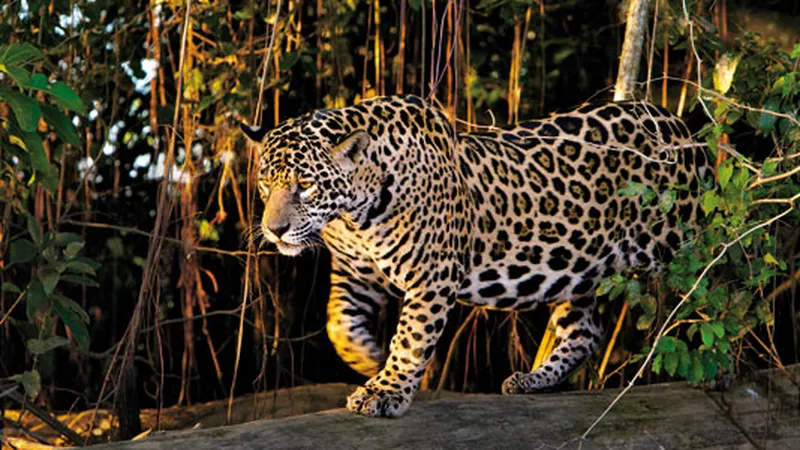Introduction
The Jaguar: A Symbol of Power and Elegance
- Evolutionary History: Tracing the Origins of the Jaguar
- The Ancestral Journey: Jaguar’s Prehistoric Roots
- Adaptations for Success: Evolutionary Traits of the Jaguar
- Habitat and Distribution: Exploring the Range of the Jaguar
- The Realm of the Jaguar: Habitat Preferences
- Geographic Distribution: Where Jaguars Roam
- Physical Characteristics: Anatomy and Appearance of the Jaguar
- Striking Coat Patterns: Understanding Jaguar’s Spots
- Powerful Build: Anatomy for Stealth and Strength
- Behavior and Social Structure: Insights into Jaguar’s Lifestyle
- Solitary Stalkers: Understanding Jaguar’s Social Behavior
- Territorial Guardians: Jaguar’s Defense of Home Range
- Hunting Strategies: The Tactics of a Supreme Predator
- Stealth and Ambush: Jaguar’s Approach to Hunting
- The Versatile Diet: Prey Preferences and Hunting Adaptations
- Reproduction and Life Cycle: From Courtship to Cub Rearing
- Mating Rituals: Courtship Behavior of Jaguars
- Maternal Care: Jaguar Cubs and Family Dynamics
- Conservation Status: Challenges and Efforts to Save the Jaguar
- Threats to Survival: Human Impact on Jaguar Population
- Conservation Initiatives: Strategies to Protect Jaguars
- Human-Jaguar Conflict: Understanding Interactions with Humans
- Livestock Predation: Conflicts with Ranchers and Farmers
- Conservation vs. Livelihoods: Balancing Needs in Jaguar Habitat
- Cultural Significance: Jaguars in Mythology and Indigenous Cultures
- Divine Beings: Jaguars in Ancient Mesoamerican Cultures
- Contemporary Symbolism: Jaguar’s Role in Modern Society
- Ecological Importance: Jaguar’s Role in Ecosystem Dynamics
- Keystone Predators: Impact of Jaguars on Ecosystem Health
- Trophic Cascade: Effects of Jaguar Decline on Biodiversity
- Captive Conservation: Jaguar Conservation Efforts in Zoos and Sanctuaries
- Role of Captive Breeding Programs in Jaguar Conservation
- Challenges and Successes: Lessons from Captive Jaguar Management
- Research and Field Studies: Advancing Knowledge of Jaguar Ecology
- Tracking Jaguars: Insights from GPS Collar Studies
- Field Observations: Studying Jaguars in their Natural Habitat
- Genetics and Population Dynamics: Insights from Jaguar DNA Studies
- Genetic Diversity: Implications for Jaguar Conservation
- Population Monitoring: Assessing Jaguar Numbers and Health
- Climate Change Impacts: Assessing Threats to Jaguar Habitats
- Habitat Fragmentation: Effects of Deforestation and Land Use Change
- Climate Vulnerability: Risks Posed by Temperature and Precipitation Shifts
- Legal Protection: International Laws Safeguarding Jaguars
- CITES Listing: International Trade Regulations for Jaguars
- National Legislation: Legal Frameworks for Jaguar Conservation
- Community Engagement: Involving Local Communities in Conservation Efforts
- Sustainable Livelihoods: Alternatives to Jaguar-Related Livestock Farming
- Education and Awareness: Empowering Communities to Protect Jaguars
- Technological Innovations: Tools for Jaguar Conservation and Research
- Camera Traps: Monitoring Jaguar Populations in Remote Areas
- GIS Mapping: Analyzing Jaguar Habitat Connectivity
- Transboundary Conservation: Collaborative Efforts for Jaguar Protection
- International Partnerships: Cooperation Across Jaguar Range Countries
- Shared Challenges: Addressing Conservation Issues Across Borders
- Future Outlook: Prospects for Jaguar Conservation and Survival
- Challenges Ahead: Persistent Threats to Jaguar Survival
- Hope for the Future: Opportunities for Jaguar Recovery
Conclusion
In Conclusion: The Enduring Legacy of the Jaguar
